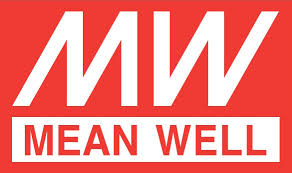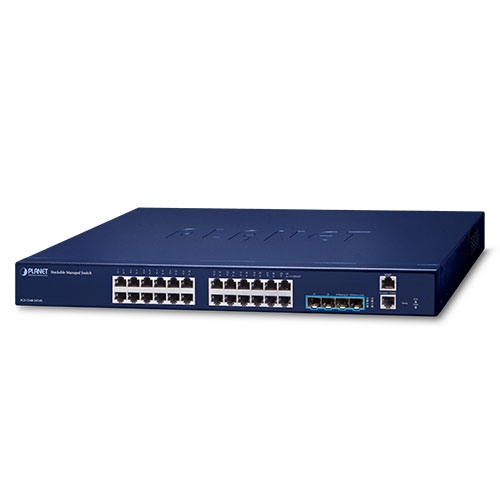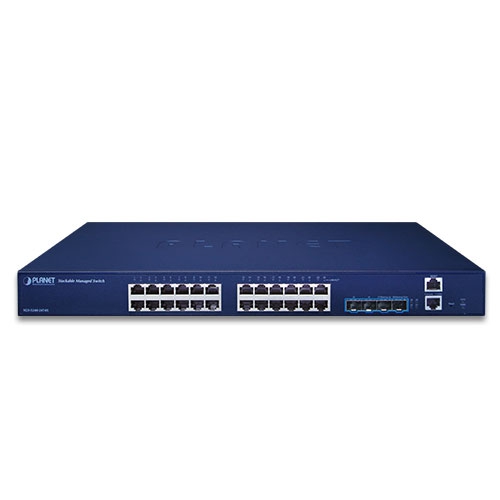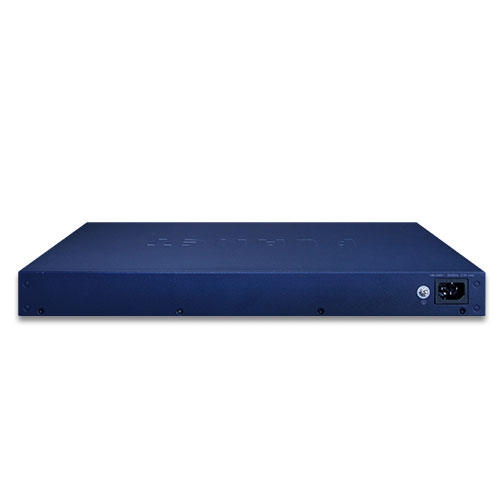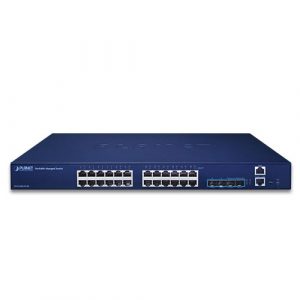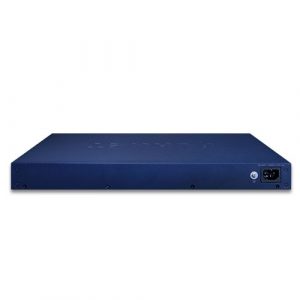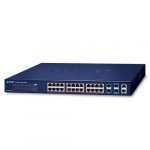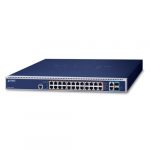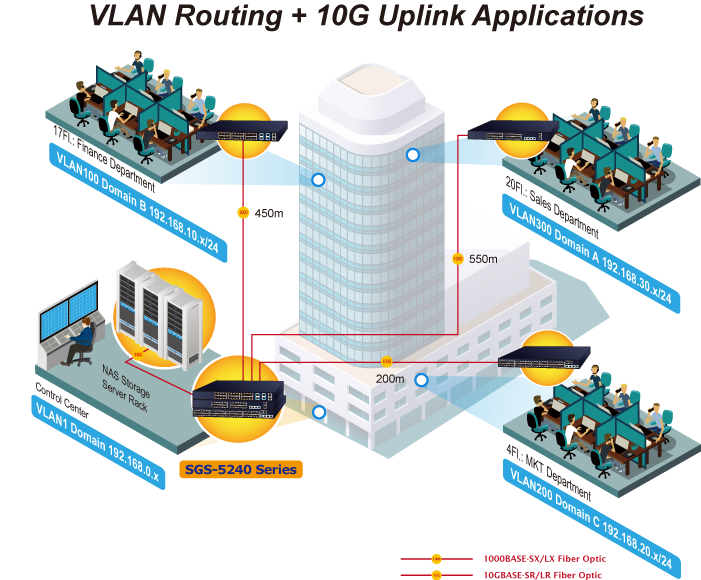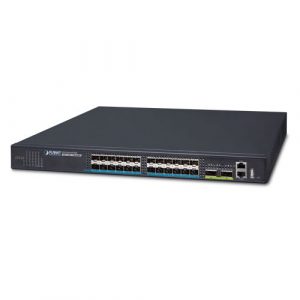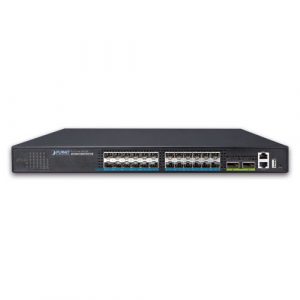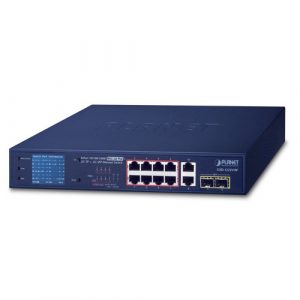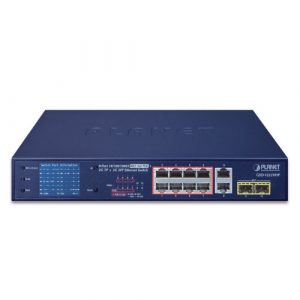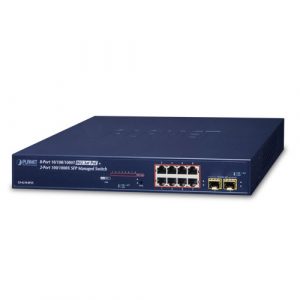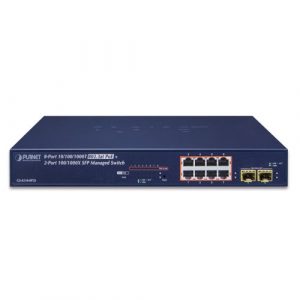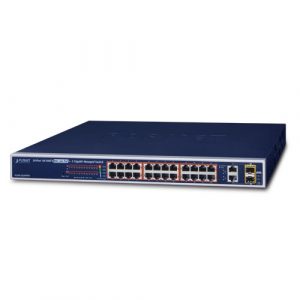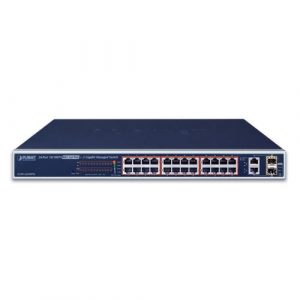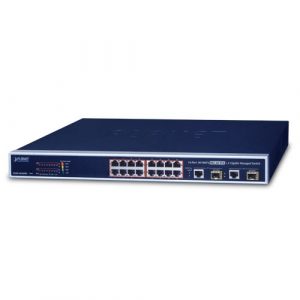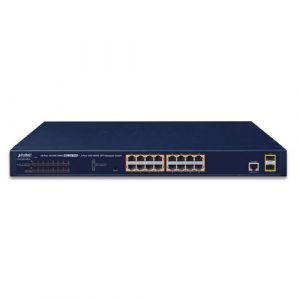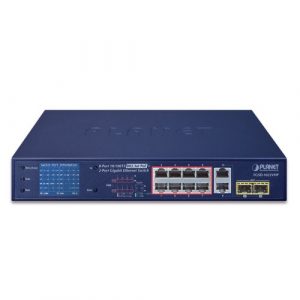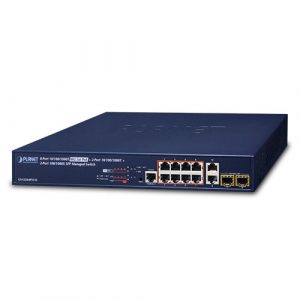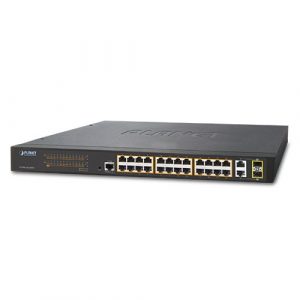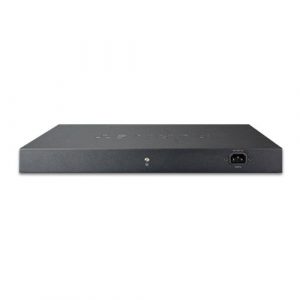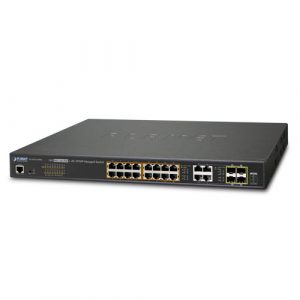SGS-5240-24T4X
Layer 2+ 24-Port 10/100/1000T + 4-Port 10G SFP+ Stackable Managed Switch
- Applicazioni
- SPECIFICHE
- DOWNLOAD
Descrizione
High Availability Mesh Networking Solution for Big Data System
By means of improving the technology of Optical Fiber Ethernet with highly-flexible, highly-extendable and easy-to-install features, the SGS-5240 series offers up to 128/176Gbps data exchange speed via Optical Fiber interface and the transmission distance can be extended to 120km.
The SGS-5240 series features strong, rapid, self-recovery capability to prevent interruptions and external intrusions. It incorporates IEEE 802.1s MSTP (Multiple Spanning Tree Protocol, spanning tree by VLAN) into customer’s automation network to enhance system reliability and uptime. The SGS-5240 series is the ideal solution for data centers, service providers and telecoms to build redundant connection and establish high bandwidth for Big Data server farm.
Excellent Solution to Core/Data Center Security and QoS Switch
The SGS-5240 series performs 128/176Gbps non-blocking switch fabric so it can easily provide a local 10Gbps high bandwidth Ethernet network for the backbone of your department. With the four built-in SFP+ ports, the SGS-5240 series provides the uplink to the backbone network through the 10G Ethernet LR/SR SFP+ modules. It further improves the network efficiency and protects the network clients by offering the security and QoS features.
Layer 3 VLAN Routing
With the built-in Layer 3 static routing capability, the SGS-5240 series ensures reliable routing between VLANs and network segments. The routing protocols can be applied via VLAN interface. The SGS-5240 series is certainly a cost-effective and ideal solution for enterprises.
| Hardware Specifications | |
|---|---|
| 10/100/1000BASE-T RJ45 Ports | 24 |
| 1000BASE-X SFP Slots | – |
| 10GBASE-X SFP+ Slots | 4 10GBASE-SR/LR SFP+ interfaces Compatible with 1000BASE-SX/LX/BX SFP transceiver |
| Console | 1 x RJ45-to-RS232 serial port (115200, 8, N, 1) |
| CPU | ARM A9 800MHz |
| RAM | 512Mbytes |
| Flash Memory | 64Mbytes |
| Dimensions (W x D x H) | 440 x 280 x 44 mm |
| Power Consumption | 21 watts/71.65 BTU |
| Power Requirements – AC | AC 100~240V, 50/60Hz |
| Power Requirements – DC | – |
| Fan | – |
| Switching | |
| Switch Architecture | Store-and-forward |
| Switch Fabric | 128Gbps/ non-blocking |
| Switch Throughput | 95.23Mpps |
| Address Table | 16K MAC address table with auto learning function |
| ARP Table | 1024 |
| ACL Table | 900 |
| Shared Data Buffer | 1.5MB |
| Jumbo Frame | 9KB |
| Flow Control | Back pressure for half duplex IEEE 802.3x pause frame for full duplex |
| Layer 3 Functions | |
| IP Interfaces | Max. 32 VLAN interfaces |
| Routing Table | IPv4 256 entries IPv6 128 entries |
| Routing Protocols | IPv4 hardware static routing IPv6 hardware static routing |
| Layer 2 Functions | |
| Port Configuration | Port disable/enable Auto-negotiation 10/100/1000Mbps full and half duplex mode selection Flow control disable/enable Port loopback detect |
| Port Status | Display each port’s speed duplex mode, link status, flow control status and auto negotiation status |
| Port Mirroring | TX/RX/Both Remote port mirror (RSPAN) Many-to-1 monitor |
| VLAN | IEEE 802.1Q tagged based VLAN, up to 4K VLAN groups IEEE 802.1ad Q-in-Q VLAN stacking/tunneling IEEE 802.1v Protocol-based VLAN Port-based VLAN MAC-based VLAN IP Subnet-based VLAN Voice VLAN GVRP for VLAN management, up to 256 VLAN |
| Spanning Tree Protocol | IEEE 802.1D Spanning Tree Protocol (STP) IEEE 802.1w Rapid Spanning Tree Protocol (RSTP) IEEE 802.1s Multiple Spanning Tree Protocol (MSTP) BPDU Guard, BPDU filtering and BPDU transparent Root Guard STP-based loopback detection |
| Multicast | IPv4 IGMP v1/v2/v3 snooping IPv4 Querier mode support IGMP Filtering and IGMP Throttling IGMP Proxy reporting IGMP mroute-forward mode Up to 255 multicast groups IPv6 MLD v1/v2 snooping Up to 255 multicast groups Multicast VLAN Register (MVR), supports 5 multicast VLANs |
| Link Aggregation | IEEE 802.3ad Ling Aggregation Control Protocol (LACP) Static trunk link aggregation Supports 26 groups with 8 ports per trunk group Up to 80Gbps bandwidth (full duplex mode) Load Balance Algorithm: – Source IP/destination IP/Source + destination IP – Source MAC/destination MAC/Source + destination MAC |
| Storm Control | Broadcast/Multicast/Unicast storm control Rate: 64Kbpss-10,000Mbps |
| Bandwidth Control | Input/Output/Both Per port bandwidth control Gigabit port: 64Kbpss-1,000Mbps 10Gigabit port: 64Kbpss-10,000Mbps |
| QoS | 8 priority queues on all switch ports Scheduling for priority queues – Weighted Round Robin (WRR) – Strict priority – Hybrid (DRR/WRR + strict) Traffic classification: – IEEE 802.1p CoS/DSCP/IP Precedence – VLAN ID – ACL – Policy-based ingress and egress QoS |
| Ring | ITUT G.8032 ERPS v1 and v2 |
| Security Functions | |
| Access Control List | Supports Standard and Expanded ACL – IP-based ACL – MAC-based ACL – ARP ACL – Time-based ACL ACL based on: – MAC Address – IPv4/IPv6 IP Address – Ethertype – Protocol-number/UDP – sport/dport – DSCP – 802.1p Priority Up to 900 entries |
| Security | Port security Supports static MAC + port binding Defend against DoS or TCP attacks DHCP Snooping, DHCP Option 82 IP source guard Dynamic ARP inspection Command line authority control based on user levels |
| AAA | RADIUS client TACACS+ client |
| Network Access Control | IEEE 802.1x port-based network access control MAC-based authentication Web authentication Local/RADIUS authentication |
| Management Functions | |
| System Configuration | Console and Telnet Web browser SNMP v1, v2c |
| Secure Management Interfaces | IPv4/IPv6 SSHv2, SSLv3, SNMPv3 Maximum 8 sessions for SSH and telnet connection |
| System Management | IPv4 and IPv6 dual stack management SNMP MIB and TRAP SNMP RMON 1, 2, 3, 9 four groups Firmware upgrade by HTTP/TFTP/FTP protocol through Ethernet network Configuration upload/download through HTTP/TFTP/FTP protocol Supports dual images and multiple configuration files Supports IEEE 802.1ab LLDP protocol NTP/SNTP client RADIUS authentication for IPv4/IPv6 login user name and password Security IP safety net management function: avoid unlawful landing at nonrestrictive area |
| Event Management | Remote Syslog System log SMTP |
| IP Clustering | 16 members |
| IP Clustering Compatibility List | SGS-5240-24T4X SGS-5240-24P4X SGS-5240-20S4C4XR SGS-5240-48T4X |
| Hardware Stacking | 6 members max. Last 2 10G SFP+ slots are functioned as Stacking Up and Down interfaces |
| SNMP MIBs | RFC 1213 MIB-II RFC 1215 Internet Engineering Task Force RFC 1271 RMON RFC 1354 IP-Forwarding MIB RFC 1493 Bridge MIB RFC 1643 Ether-like MIB RFC 1907 SNMP v2 RFC 2011 IP/ICMP MIB RFC 2012 TCP MIB RFC 2013 UDP MIB RFC 2096 IP forward MIB RFC 2233 if MIB RFC 2452 TCP6 MIB RFC 2454 UDP6 MIB RFC 2465 IPv6 MIB RFC 2466 ICMP6 MIB RFC 2573 SNMP v3 notify RFC 2574 SNMP v3 vacm RFC 2674 Bridge MIB Extensions (IEEE 802.1Q MIB) RFC 2674 Bridge MIB Extensions (IEEE 802.1P MIB) |
| Standard Conformance | |
| Regulatory Compliance | FCC Part 15 Class A, CE |
| Standards Compliance | IEEE 802.3 10BASE-T IEEE 802.3u 100BASE-TX IEEE 802.3z Gigabit 1000BASE-SX/LX IEEE 802.3ab Gigabit 1000BASE-T IEEE 802.3ae 10Gb/s Ethernet IEEE 802.3x flow control and back pressure IEEE 802.3ad port trunk with LACP IEEE 802.1D Spanning Tree Protocol IEEE 802.1w Rapid Spanning Tree Protocol IEEE 802.1s Multiple Spanning Tree Protocol IEEE 802.1p Class of Service IEEE 802.1Q VLAN tagging IEEE 802.1ad Q-in-Q VLAN stacking/tunneling IEEE 802.1v Protocol-based VLAN IEEE 802.1X port authentication network control IEEE 802.1ab LLDP RFC 768 UDP RFC 793 TFTP RFC 791 IP RFC 792 ICMP RFC 2068 HTTP RFC 1112 IGMP v1 RFC 2236 IGMP v2 RFC 3376 IGMP v3 RFC 2710 MLD v1 FRC 3810 MLD v2 ITU-T G.8032 ERPS Ring |
| Environments | |
| Operating | Temperature: 0 ~ 50 degrees C Relative Humidity: 5 ~ 90% (non-condensing) |
| Storage | Temperature: -10 ~ 70 degrees C Relative Humidity: 5 ~ 90% (non-condensing) |



